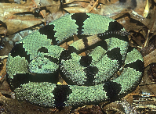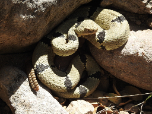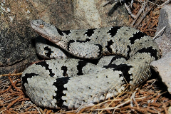Banded Rock Rattlesnake (Crotalus lepidus klauberi)
Description: Adults rarely grow to more than 24 inches in length. The color pattern is typically a light grey with darker grey banding that varies greatly from habitat to habitat. The background color may be green to purple in some locations. Those found in the Franklin Mountain range of El Paso County in Texas are unique, having a striking pearl silver background and well defined black crossbands.
The characters used to distinguish the various subspecies have been a point of contention for many years. Various sources have used scale counts, number of bands, the stripe along the eye region and the amount of mottling between bands as methods to tell them apart. Unfortunately, research has shown that there are always exceptions. It is generally accepted, however, that C. l. klauberi lacks mottling between the darker bands, even though this is not an entirely reliable method. It is not known whether the subspecies intergrade in the areas where their ranges overlap.
Habitat: This snake occurs mainly in rocky mountainous areas, including talus slopes, gorges, rimrock, limestone outcrops, and rocky streambeds, often in arid or semi-arid areas vegetated with pine-oak, oak-juniper, pinyon pine, ponderosa pine, or agave; it also inhabits mesquite grasslands and rocky desert flats and canyons, as well as mixed boreal-tropical forest and tropical deciduous forest in Mexico. In forests it tends to occupy open sunny areas. It is a terrestrial species that may sometimes climb into low vegetation. It takes refuge under or among rocks, in animal burrows, or in or under stumps or similar refuges.
Range: In the United States C. l. klauberi is found in Arizona, New Mexico and Texas.
Found in these States:
AZ |
NM |
TX
Venom: Their venom is primarily a hemotoxin, but has been known to have significant neurotoxic effects, as well.[citation needed] While not type-specific, the polyvalent antivenin CroFab is generally used to treat serious envenomations.
Diet: Their diet consists of primarily lizards and rodents.
Reproduction: Ovoviviparous, with females giving birth to 2-8 young in the spring. Mating occurs in the summer months, after which gravid females hibernate during the winter months.
Status: Listed as Least Concern in view of its wide distribution, presumed large population, and because it is unlikely to be declining fast enough to qualify for listing in a more threatened category.
»» Kingdom: Animalia - Animals
»» Phylum: Chordata - Chordates
»» Subphylum: Vertebrata - Vertebrates
»» Class: Reptilia - Reptiles
»» Order: Squamata - Scaled Reptiles
»» Suborder: Serpentes
»» Clade: Colubroides
»» Family: Viperidae - Vipers
»» Genus: Crotalus
»» Species: Crotalus lepidus - Rock Rattlesnake
»» Subspecies: Crotalus lepidus klauberi - Banded Rock Rattlesnake
This article uses material from the Wikipedia article "Crotalus lepidus klauberi", which is released under the Creative Commons Attribution-Share-Alike License 3.0. Content may have been omitted from the original, but no content has been changed or extended.
|









